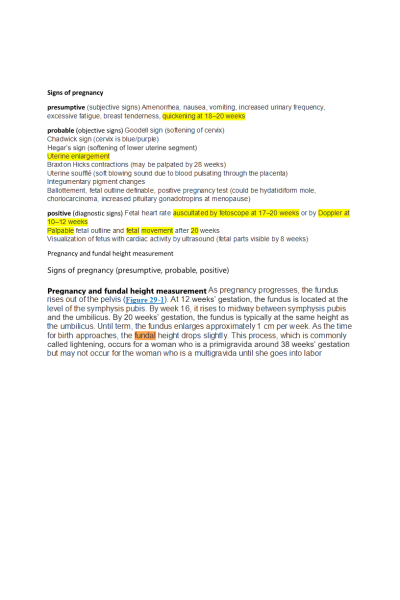NR 602 Week 4 Midterm Review-Study Guide
-
$35.00
| Institution | NR 602 Primary Care of the Childbearing and Childrearing Family |
| Contributor | Jennifer Lopez |
Preview of Starting Page…..
Signs of pregnancy
presumptive (subjective signs) Amenorrhea, nausea, vomiting, increased urinary frequency, excessive fatigue, breast tenderness, quickening at 18–20 weeks
probable (objective signs) Goodell sign (softening of cervix)
Chadwick sign (cervix is blue/purple)
Hegar’s sign (softening of lower uterine segment)
Uterine enlargement
Braxton Hicks contractions (may be palpated by 28 weeks)
Uterine soufflé (soft blowing sound due to blood pulsating through the placenta)
Integumentary pigment changes
Ballottement, fetal outline definable, positive pregnancy test (could be hydatidiform mole, choriocarcinoma, increased pituitary gonadotropins at menopause)
positive (diagnostic signs) Fetal heart rate auscultated by fetoscope at 17–20 weeks or by Doppler at 10–12 weeks
Palpable fetal outline and fetal movement after 20 weeks
Visualization of fetus with cardiac activity by ultrasound (fetal parts visible by 8 weeks)
Pregnancy and fundal height measurement
Signs of pregnancy (presumptive, probable, positive)
Pregnancy and fundal height measurement As pregnancy progresses, the fundus rises out of the pelvis (Figure 29-1). At 12 weeks’ gestation, the fundus is located at the level of the symphysis pubis. By week 16, it rises to midway between symphysis pubis and the umbilicus. By 20 weeks’ gestation, the fundus is typically at the same height as the umbilicus. Until term, the fundus enlarges approximately 1 cm per week. As the time for birth approaches, the fundal height drops slightly.....
Preview of Last Page…..
Breastfeeding American Dietetic Association recommend breastfeeding exclusively for the first 6 months of life and then continued breastfeeding in combination with other nutrients for at least the first year. One model that can be used to further these goals encourages providers to focus on interventions that (1) support the mother’s self-efficacy to breastfeed, (2) provide lactation support to mother and family, and (3) increase lactation education for both mother and providers a lower risk of nonspecific bacterial infections, necrotizing enterocolitis, acute otitis media in early childhood, asthma, excessive weight gain, type 2 diabetes, and sudden infant death syndrome (SIDS) decreased risk for breast and ovarian cancer (Ross-Cowerdy, 2017). In addition, breastfeeding is associated with short-term and long-term benefits that protect against cardiovascular risks associated with metabolic syndrome type, hypertension, and cardiovascular disease
- Contra: Infant with classic galactosemia
- • Maternal diagnosis of human T-cell lymphotropic virus type I or II
- • Maternal diagnosis of untreated brucellosis
- • Maternal diagnosis of cancer and treatment
- • Maternal human immunodeficiency virus (HIV) infection (except in some areas, see WHO recommendations [Box 16.1]; breastfeeding for HIV-infected mothers is not recommended in developed countries)
- • Herpetic lesions on the mother’s nipples, areolas, or breast (expressed breast milk can be fed to the infant)
- • Maternal use of cocaine, phencyclidine (PCP), and cannabis
By approximately 20 weeks, the breast is capable of milk production. he infant should be encouraged to go to each breast for at least 10 to 15 minutes of active suckling, although some infants may spend even longer—up to 20 or 30 minutes. The infant’s behavior is much more important during this time than the clock. However, an infant who falls asleep in 5 minutes should be stimulated to continue active suckling. After the first 24 hours, the infant should be going to the breast 8 to 12 times (or every 2 to 3 hours) in 24 hours for approximately 20 to 45 minutes at each feeding. Frequent suckling stimulates milk production and establishes a regular routine. Exclusive feeding at the breast for the first 4 to 6 weeks should be encouraged to ensure the establishment of adequate milk supply and prevent any nipple preference. Parents need to be on alert if their infant sleeps more than 4 to 5 hours at a time or goes to sleep at the breast in 5 minutes. This infant must be actively wakened and stimulated for feeding. Normal newborn infants lose 5% to 10% of their birth weight in the first few days of life. It is helpful for parents to be aware of both the birth and discharge weights. Once the maternal milk volume increases, the infant begins to gain weight in the range of 0.5 to 1 oz/day or 4 to 7 oz/week. Many breastfed infants have regained their birth weight by 2 weeks, and others may take up to 3 to 4 weeks before return to birth weight is achieved (Paul et al., 2016). Breastfed infants usually double their birth weight by the time they are 4 to 6 months old and triple it by 1 year old........continue
End of Document Preview
| Instituition / Term | |
| Term | Summer 2020 |
| Institution | NR 602 Primary Care of the Childbearing and Childrearing Family |
| Contributor | Jennifer Lopez |











-80x80.png)














-80x80.png)
-80x80.png)







-80x80.png)




















